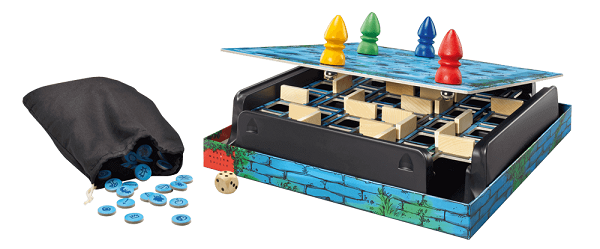The Magic Labyrinth: Master the Maze Memory Game

A tricky labyrinth awaits you, one where you can’t see the walls until it’s too late. Can you find your way and remember it once found?
A unique maze game in which players must navigate a maze without knowing exactly where the walls are, The Magic Labyrinth uses magnets and a double-layered board to create a unique gaming experience. Now 10 years after its initial release, it still remains a favorite.
Gameplay
The game consists of a two-layered board. On the lower portion of the board, players place a series of walls. The top layer is then placed on top of this. The top layer features a grid of square spaces, some blank but most featuring a magical symbol.
Each player puts his pawn at one of the four starting corners, and attaches a magnetic metal ball to the pawn, beneath the top layer of the board. When your pawn moves across the top of the board, the ball will follow beneath the board.
A symbol token is drawn at random from a bag. Players are competing to be the first to reach the space on the board that matches this symbol. On your turn you roll a die, and may then move your pawn up to the number of spaces that you rolled. You must move in straight lines (never diagonally) and must move your pawn quickly (not allowed to test to see if a wall is in the way). If your metal ball hits a wall on the bottom layer, it will be knocked off your pawn, and roll to the edge of the board. You then remove the ball, and must start over again at your starting corner.
The player that reaches the correct space first, stops their movement and gets to take the matching token. A new token is then pulled from the bag. The first player to collect five tokens wins the game.

Review
The Magic Labyrinth is something really unique. Its double-layered board is cleverly designed and the walls for the lower layer are removable, so that the maze can be changed each time you play.
It is a clever implementation of memory mechanics as players slowly learn where the walls are and learn which paths not to take. You learn as much from watching other players’ turns as from taking your own. As the game progresses, it speeds up, as you start to fill out the maze in your head, and players have to start over less often.
While you do have a roll and move mechanic, the die is not a standard six-sided dice. Rather its results are: 1, 2, 2, 3, 3, 4. You are never going to jump too far ahead based solely on the rolls. It’s the luck of the tokens drawn that is a bit more problematic. If a player is already on the matching space when a symbol is drawn, they automatically claim it. Or a symbol may be drawn that is just much easier for you to reach than your opponents. There’s not really any way to mitigate this, however the speed of the turns and the game itself makes this less of an issue than it might be in a more complex board game.
The Magic Labyrinth has easy to learn rules and is great for families, since the difficulty of the mazes itself can also be adjusted. The components are high quality and the gameplay something special. If you enjoy memory elements, the game uses them in an extremely clever way, and it’s satisfying to master each maze, or fumble your way through one.
Pros: Customizable maze, high quality components, unique implementation of memory elements, great for families
Cons: Luck can swing the game a bit too much







